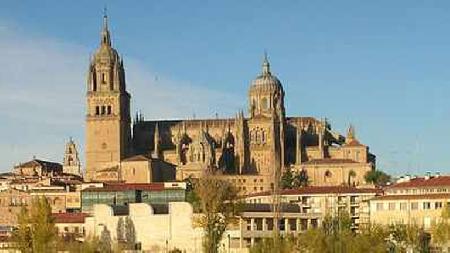 Salamanca is a small university town located in the autonomous community of Castilla y León. It is one of the oldest settlements in the country, which has a history of more than a thousand years. Almost since its foundation it has been the most important cultural and historical center in its region, and since 2002 it is also the European Capital of Culture. Salamanca has a population of 150,000 inhabitants located in the central west of Spain. It is the capital of the province of Salamanca, which in turn is part of the autonomous region of Castilla y León. Salamanca is mainly known for its university, founded in 1218 by King Alfonso IX. It is considered the oldest university in Europe and today one of the most prestigious. It was once the home of Lope de Vega and Cervantes. Salamanca is a city of students, but with students the city is visited by many tourists from all over the world.
Salamanca is a small university town located in the autonomous community of Castilla y León. It is one of the oldest settlements in the country, which has a history of more than a thousand years. Almost since its foundation it has been the most important cultural and historical center in its region, and since 2002 it is also the European Capital of Culture. Salamanca has a population of 150,000 inhabitants located in the central west of Spain. It is the capital of the province of Salamanca, which in turn is part of the autonomous region of Castilla y León. Salamanca is mainly known for its university, founded in 1218 by King Alfonso IX. It is considered the oldest university in Europe and today one of the most prestigious. It was once the home of Lope de Vega and Cervantes. Salamanca is a city of students, but with students the city is visited by many tourists from all over the world.
The city in western Spain is interesting for its oldest university, as well as for its impressive architecture, which has absorbed various trends. Spend a few days in Salamanca to immerse yourself in the oldest academic environment in Spain. The local university was founded in 1218. For centuries, this city has lived a vibrant and lively life and today its university team, together with regular visitors, create a dynamic and cosmopolitan atmosphere while still respecting tradition.
Main Square:
Located in the heart of the Old Town. Since its foundation in 1729, this place has hardly changed. This plaza is still surrounded by three-story buildings with arcades erected in the late 17th and early 18th centuries, and a luxurious Renaissance palace stands in the southwest corner.
As in previous times, Plaza Mayor is the center of city life and a favorite vacation destination for locals. But while traditional Sunday fairs, executions, and bullfights used to be held here, now there are cozy restaurants and ice cream parlors that gather numerous students from the city.
University of Salamanca:
The school, which became the alma mater of a plethora of prominent Spanish personalities, was founded in the first half of the 13th century. Over the years, one of the oldest universities in Spain has experienced many historical events, but this has not prevented it from maintaining not only its high status, but also a unique façade, dating from 1534 and decorated with many decorative elements. . The most famous of them is the image of a frog under its skull, which is considered a symbol of death and lust in one version, and in the other - the signature of the masons who participated in the construction of the university. In any case, local students believe that anyone who can find this figure can count on the success of the session.
Museum of Modern Art and Art Deco:
The Museum of Art Nouveau and Art Deco Casa Lis, which opened in 1995, can be said to be almost the most interesting art gallery in Salamanca. Its collection of more than 2.5 thousand copies introduces visitors to the most fruitful period in the history of Spanish art.
The museum's collection includes 19 sections dedicated to this or that industry. In its salons you can see jewelry, furniture, earthenware, paintings, statuettes, antique toys, Fabergé eggs, enamels and artistic glass products, as well as many other unique creations by famous Spanish and European manufacturers. A special place in all this diversity is occupied by French porcelain dolls, which date from the mid-19th century. and a collection of gold and metal figures.
The New and Old Cathedral:
The Old Cathedral, founded in the 12th century, decided to destroy it when the construction of a new Gothic-style cathedral began in the 16th century. Fortunately, however, the project did not proceed as expected, and the "old" Romanesque cathedral has been preserved in its pristine beauty. The place where they come together is known as Patio Chico, one of the most charming parts of the city.
House of deaths:
The House of Deaths is a 16th century Plateresque palace designed by Juan de Álava with cursed legends and dark stories. The four stone skulls "hanging" from the joints of the two upper windows of the facade, along with the murders that took place in the house gave it this name.
